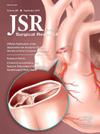Insights From Bone and Muscle Oxygenation Toward a More Comprehensive Model of Tissue Healing
IF 1.7
3区 医学
Q2 SURGERY
引用次数: 0
Abstract
Introduction
Predicting healing after amputation and revascularization in diabetes and PAD patients with tissue loss is challenging. Current methods, like transcutaneous oximetry, only measure skin oxygenation, overlooking deeper tissues critical for wound healing. Near-infrared spectroscopy (NIRS) during postocclusive reactive hyperemia (PORH) measures muscle oxygenation under ischemic stress but does not account for bone, which is crucial in healing of complex wounds. This study employed NIRS during PORH to evaluate both bone and muscle perfusion in a swine model of hindlimb ischemia.
Methods
Eight Ossabaw swine underwent right hindlimb ischemia induction via endovascular coil occlusion of the right external iliac, femoral, and popliteal arteries. PORH was performed before (T0) and 4 wk after ischemia induction (T4) using a 5-min infrarenal aortic occlusion, with NIRS recording oximetry changes in bilateral gastrocnemius muscle and metatarsal bones. Data endpoints were derived in MATLAB.
Results
At T0 (normal circulation), bone showed a smaller StO2 drop (P = 0.008), slower oxygen decline (P = 0.050), and smaller oxygen deficit (P = 0.027) during occlusion, along with slower recovery (P < 0.001) during PORH reperfusion. At T4, ischemic bone and muscle had reduced oximetry drops, smaller oxygen deficits, and slower recovery relative to nonischemic tissues. Notably, ischemic bone maintained occlusion rates but had diminished hyperemia response (P = 0.038), differing from muscle dynamics.
Conclusions
Bone and muscle display distinct oxygenation dynamics under ischemia. Chronic ischemia attenuates metabolic and reperfusion responses in both tissues. These findings highlight bone's under-recognized role in ischemia/reperfusion events and the need for comprehensive tissue-specific oxygenation models to predict healing outcomes.
从骨骼和肌肉氧合到更全面的组织愈合模型的见解
预测糖尿病和PAD患者截肢和血管重建术后的愈合是具有挑战性的。目前的方法,如经皮血氧仪,只测量皮肤氧合,而忽略了对伤口愈合至关重要的深层组织。闭合后反应性充血(PORH)期间的近红外光谱(NIRS)测量缺血应激下的肌肉氧合,但不考虑骨骼,这对复杂伤口的愈合至关重要。本研究采用近红外光谱(NIRS)对猪后肢缺血模型的骨和肌肉灌注进行了评价。方法采用血管内线圈闭塞右髂外动脉、股外动脉和腘动脉诱导右后肢缺血。在缺血诱导前(T0)和缺血诱导后(T4) 4周,采用5分钟的肾下主动脉阻断进行PORH,近红外光谱记录双侧腓肠肌和跖骨的血氧变化。在MATLAB中导出数据端点。结果在T0(正常循环)中,骨在闭塞时StO2下降较小(P = 0.008),氧下降较慢(P = 0.050),氧亏较小(P = 0.027), PORH再灌注时恢复较慢(P < 0.001)。在T4时,相对于非缺血组织,缺血骨和肌肉的血氧下降减少,缺氧更小,恢复更慢。值得注意的是,缺血性骨维持了闭塞率,但充血反应减弱(P = 0.038),与肌肉动力学不同。结论缺血时骨和肌肉表现出不同的氧合动力学。慢性缺血会减弱两种组织的代谢和再灌注反应。这些发现强调了骨在缺血/再灌注事件中未被充分认识的作用,以及需要全面的组织特异性氧合模型来预测愈合结果。
本文章由计算机程序翻译,如有差异,请以英文原文为准。
求助全文
约1分钟内获得全文
求助全文
来源期刊
CiteScore
3.90
自引率
4.50%
发文量
627
审稿时长
138 days
期刊介绍:
The Journal of Surgical Research: Clinical and Laboratory Investigation publishes original articles concerned with clinical and laboratory investigations relevant to surgical practice and teaching. The journal emphasizes reports of clinical investigations or fundamental research bearing directly on surgical management that will be of general interest to a broad range of surgeons and surgical researchers. The articles presented need not have been the products of surgeons or of surgical laboratories.
The Journal of Surgical Research also features review articles and special articles relating to educational, research, or social issues of interest to the academic surgical community.

 求助内容:
求助内容: 应助结果提醒方式:
应助结果提醒方式:


